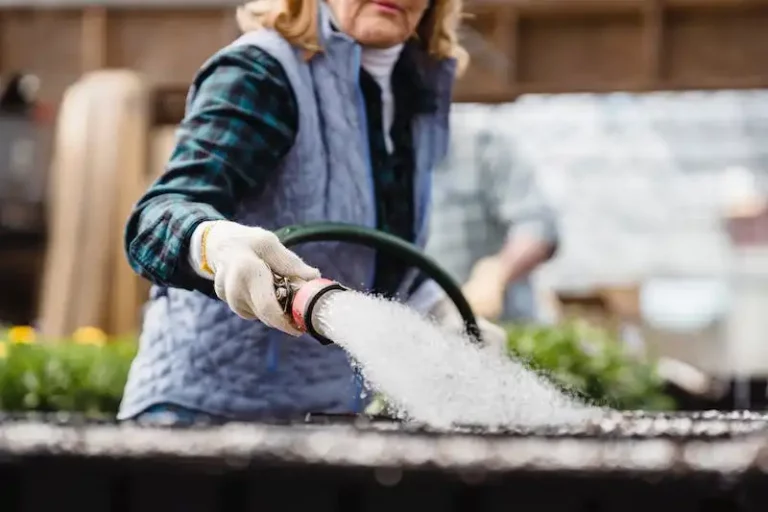If you have a shady garden area and you’re looking to add some color and fragrance, climbing roses can be the perfect choice. These beautiful roses can brighten up any dark corner of your yard and create a stunning focal point. With their generous clusters of gorgeous blooms and pleasant fragrance, they are sure to be a favorite for any gardener.
One of the best climbing roses for shady garden areas is the ‘Emily Galway’ rose. This easy-to-grow rose is disease resistant and can tolerate partial sunlight, making it perfect for semi-shaded areas. It produces large clusters of dark pink flowers that are not only beautiful but also have a wonderful fragrance.
Another great option is the ‘Ausblush’ rose, which is a hybrid tea rose that is known for its disease resistance and generous bloom. It produces stunning, large, and fully double flowers in a soft pink color. With its strong fragrance and ability to thrive in shaded areas, this rose is a favorite among gardeners.
If you’re looking for a thornless variety, the ‘Beveridge Beach’ rose is a perfect choice. This easy-to-grow rose produces medium-sized, pale pink flowers that have a delightful fragrance. Its thornless stems make it ideal for planting in areas where people may come into contact with it.
The ‘Rambling Georgia’ rose is another excellent choice for shaded garden areas. This rose, with its large, single, bright yellow flowers, can easily brighten up any dark corner of your yard. It is a vigorous grower and can easily cover large areas or climb up trees or trellises.
If you want a rose that is not only beautiful but also easy to care for, the ‘Teasing Georgia’ rose is a great option. This rose, with its stunning large, deep golden-yellow blooms, is disease resistant and requires minimal maintenance. It can tolerate partial shade and can be grown in containers.
The ‘Knock Out’ series of roses are also a popular choice among gardeners. The ‘Knock Out’ roses are known for their disease resistance, generous blooms, and easy care. They can tolerate partial shade and produce clusters of beautiful flowers in various colors, including red, pink, and yellow.
When planting climbing roses in shaded areas, it’s important to choose the right spot. Look for an area that receives at least a few hours of morning sunlight or dappled sunlight throughout the day. Prepare the planting area by loosening the soil and incorporating compost or well-rotted manure to improve drainage and fertility.
Once planted, be sure to water your climbing roses regularly, especially during dry periods. Mulching around the base of the plants can help retain moisture and prevent weeds. Prune your roses in late winter or early spring to remove any dead or damaged wood and shape the plants.
With their stunning beauty and fragrant blooms, climbing roses can add a touch of elegance to any shady garden area. Whether you choose a hybrid tea rose, a rambling rose, or a floribunda rose, you’re sure to enjoy the beauty and fragrance that these roses bring to your outdoor space.
Top Tips: When planting climbing roses in shady areas, choose varieties that are known for their ability to thrive in semi-shade. Be sure to prepare the planting area by incorporating organic matter and ensure that the soil is well-drained. Regular watering, mulching, and proper pruning will help your climbing roses thrive in shaded areas.
Roses for Shade
When it comes to growing roses, it’s often assumed that they need full sun to thrive. However, there are several varieties that can do well in shaded areas of the garden, including climbers and ramblers. If you have a shady garden area and are looking to add some vibrant color, these roses are worth considering.
One of the best roses for shady areas is the climbing rose ‘Zephirine Drouhin’. This easy-to-grow variety can tolerate some shade and produces beautiful, fragrant blooms in a vibrant pink color. Another great option is the ‘Paul’s Himalayan Musk’ rambling rose, which can grow in semi-shade and has clusters of small, delicate pink flowers.
If you’re looking for a more compact rose, the ‘Phyllis Bide’ hybrid tea rose is a great choice. It has semi-shade tolerance and produces clusters of small, pale yellow blooms. Similarly, the ‘Meimirrote’ climbing rose (also known as the ‘Austin’ rose) is a vigorous grower that can tolerate some shade and produces large, double blooms in a soft pink color.
For those who prefer a more wild look, the ‘Rosa setigera’ or ‘Prairie rose’ is a native North American rose that can grow in shady areas. It has single, pink blooms and can be used to cover fences or trellises.
When planting roses in shady areas, it’s important to ensure that they still receive a few hours of sunlight each day. While these varieties can tolerate shade, they still need some light to thrive. Additionally, adding some organic matter such as compost or well-rotted manure to the soil can help improve drainage and fertility.
Overall, while roses may not be the first choice for shady gardens, there are a number of varieties that can still thrive in these conditions. Whether you prefer climbers, ramblers, or compact hybrids, there’s a rose out there that can bring color and beauty to your shaded garden area.
Things to Know about Growing Roses in Shade
Growing roses in a shady garden area can be a challenge, but with the right knowledge and care, it is possible to have beautiful blooms. Here are some important things to consider if you want to grow roses in the shade:
- Sunlight: While roses love sunlight, some varieties can tolerate shady conditions. Look for roses that are labeled as shade-tolerant or that are known to do well in partial shade.
- Level of Shade: It’s important to understand the level of shade in your garden. Is it light shade from trees or heavy shade from buildings? Different roses have different shade tolerance levels, so knowing the level of shade will help you choose the right variety.
- Choosing the Right Variety: Some roses are naturally more tolerant of shade than others. Some popular shade-tolerant varieties include ‘Alberic Barbier,’ ‘Somerset,’ ‘Phyllis Bide,’ and ‘Paul’s Himalayan Musk.’ These varieties are known for their ability to thrive in less sunlight.
- Soil Conditions: Roses grown in shady areas may have different soil requirements compared to those grown in full sunlight. Make sure the soil has good drainage and is rich in organic matter. Adding compost or well-rotted manure can help improve the soil quality and provide nutrients for the roses.
- Watering: Roses in the shade may not require as much water as those in full sun. Check the moisture level of the soil regularly and water accordingly. Overwatering can lead to root rot, so it’s important to find the right balance.
- Pest and Disease Control: Roses in shady areas may be more prone to certain pests and diseases. Keep a close eye on your roses and take action at the first sign of trouble. Regularly inspect the leaves for any signs of pests or diseases, and treat them accordingly.
- Pruning: Pruning is an important part of rose care and can help shape the plants and encourage new growth. Prune roses lightly in late winter or early spring to remove dead or damaged wood and to improve air circulation.
- Mulching: Mulching can help retain moisture in the soil and prevent weeds from growing around the roses. Apply a layer of organic mulch, such as wood chips or compost, around the base of the plants.
With these tips, you can successfully grow roses in shade and enjoy their beautiful blooms. While roses may not flower as abundantly in shady areas, they can still add beauty to your garden and provide a lovely fragrance.
Apricot Rose Rosa meimirrote – The Prettiest Roses for Shade
Apricot Rose Rosa meimirrote is one of the prettiest climbing roses that thrives in shady garden areas. With its delicate apricot-colored blooms, this rose variety adds a touch of charm and beauty to any yard.
What makes Apricot Rose Rosa meimirrote stand out is its ability to grow and bloom in shade. While most roses require at least 6 hours of direct sunlight per day to thrive, this variety can tolerate partial shade and still produce abundant flowers. This makes it an excellent choice for gardens with trees or fences that create shady areas.
Another advantage of Apricot Rose Rosa meimirrote is its strong and disease-resistant nature. It can withstand common rose diseases like black spot and powdery mildew, making it a low-maintenance option for gardeners. Plus, its growth habit is relatively compact, making it suitable for smaller gardens or borders.
When planting Apricot Rose Rosa meimirrote, it’s essential to prepare the soil properly. Amend the soil with organic matter like compost or well-rotted manure to improve drainage and provide nutrients. This will ensure that the rose has a good foundation to grow and thrive.
Once planted, Apricot Rose Rosa meimirrote requires regular care to keep it in shape and encourage blooming. Pruning is recommended once a year in late winter or early spring to remove dead or diseased wood and maintain its shape. Additionally, monthly fertilizing with a balanced rose fertilizer will provide the necessary nutrients for healthy growth.
If you have a shaded garden area and are looking for the prettiest roses to brighten it up, Apricot Rose Rosa meimirrote is an excellent choice. Its stunning apricot-colored blooms, strong growth, and ability to tolerate shade make it a standout option for any garden. Whether you choose to plant it along fences or in larger borders, this rose variety will easily add beauty and elegance to your yard.
Source: www.davidaustinroses.com
Hybrid Tea Rose Rosa x hybrida
Hybrid Tea Rose Rosa x hybrida, also known as the ‘Galway’ rose or ‘Meimirrote Skelly,Noel’, is a beautiful climbing rose that can be grown in shady garden areas. It is loved by gardeners for its easy-to-grow nature and vibrant blooms.
This rose is a hybrid between rosa gallica and rosa hybrida, resulting in a plant that has the best features of both parents. The flowers are semi-double and larger than other roses, and they retain their shape and color for a longer period of time. They also have a generous fragrance that fills the garden with a delightful scent.
Hybrid Tea Rose Rosa x hybrida is a versatile rose that can be grown in zones 5 to 9. It can tolerate a wide range of soil conditions and can be grown near trees or other plants without any issues. It prefers a spot with partial shade, receiving about 4 to 6 hours of sunlight daily.
To plant Hybrid Tea Rose Rosa x hybrida, prepare the soil by removing any weeds and adding organic matter. Dig a hole that is about 12 inches deep and wide enough to accommodate the root ball of the plant. Place the rose in the hole and backfill with soil, firming it gently around the roots. Water the plant thoroughly after planting, and apply a layer of mulch to retain moisture and suppress weeds.
Hybrid Tea Rose Rosa x hybrida is a great choice for gardeners who love climbing roses but have shady garden areas. Its vibrant blooms, easy-to-grow nature, and fragrance make it one of the prettiest roses to have in your garden. Whether you are a seasoned gardener or a beginner, this rose will surely bring beauty to your outdoor space.
Photos:
1. Rosa x hybrida ‘Zephirine Drouhin’
2. Rosa x hybrida ‘Georgia’ – Semi-double Rose
3. Rosa x hybrida ‘Rector’ – Thornless Rose
Source: 15 Best Climbing Roses For Shady Garden Areas




